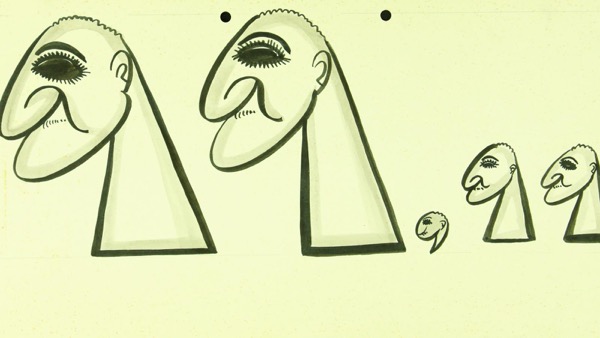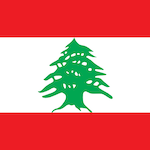
By Samar Kadi
Visitors to Beirut’s Sursock Museum were thrust back decades, watching Lebanon’s recent history marred by war, Israeli occupation and political instability displayed at “Picturing History,” an exhibition of the work of Lebanese political cartoonist Pierre Sadek.
The exhibition, the first since Sadek’s death in 2013, features 720 drawings that commented on the events of Lebanon and the region over five decades of political and violent turmoil.
“What you see here is only 2% of Pierre Sadek’s archives, which include some 30,000 caricatures,” said Ghada Sadek Abela, president of the Pierre Sadek Foundation and the artist’s daughter. “Chronologically, the works recount the history of Lebanon since the late 1950s until his death. They also cover major events that took place in the Arab region and internationally.”
“Each of his caricatures tackled a timely issue. Pierre Sadek left an entire archive, a legacy that we are seeking to conserve and transmit to the young generation,” Abela said.
Sadek’s main cartoon character was Touma, who personified the average Lebanese citizen, a respectable working-class person, honest and humble, bearing the suffering of war, injustice, failed politics and daily mishaps.
“When Pierre hid behind the persona Touma, he could laugh, be sarcastic, angry and critical poking at wounds without making them bleed anew,” Abela said.
Sadek’s images recorded history but sometimes also helped to make it. He was a man of few words but the shorthand language he devised spoke directly to the conscience and unsettled the course of nations. “Pierre’s cartoons sometimes shook governments and sped their downfall. We, as his family, often felt threatened from retaliation to his drawings,” Abela said.
Sadek contributed to several Lebanese and Arabic dailies and local television broadcasts, mainly the leading An-Nahar newspaper — where he spent more than 20 years — LBC TV and Future TV. He was published internationally by various magazines, newspapers and news agencies such as the Associated Press, United Press International, Time magazine, Le Matin, France-Soir and the Washington Post.
“Pierre Sadek pioneered televised animated caricatures following nightly newscasts on LBC and FTV. When he worked in An-Nahar, newsstands and bookshops sometimes displayed the newspaper’s back page rather than its front page, because his caricature was so popular and attracted readers,” Abela said.
In the 1960s when a caricature was a small drawing occupying the inner pages of newspapers, Sadek’s drawings covered eight columns on the top of the back page of An-Nahar as they were as informative and analytical as the lead front-page story.
Sadek’s drawings captured major political phases in Lebanon and the region. These included the heavy-handed control of the Second Bureau or Army intelligence under Presidents Fouad Chehab and Charles Helou; the Palestinian guerrilla presence, which became so entrenched in Lebanon that Palestinian leader Yasser Arafat would brag about controlling the country; the period of Syrian military hegemony over Lebanon, which ended in 2005 with the assassination of former Prime Minister Rafik Hariri; the suffering of the Palestinians under Israeli occupation and the 1967 Arab defeat at Israel’s hands, among others.
One drawing from 1970 depicting the Middle East as a ticking time bomb, being the battleground between Moscow and Washington, is as true today as it was then. A caricature from October 2000 about Jerusalem and the injustices suffered by the Palestinians couldn’t be timelier. A drawing about the 1973 Arab-Israeli war showed US President Richard Nixon and Soviet leader Alexei Kosygin weeping tears in the form of rockets on the Middle East. A 1965 caricature shows Egyptian President Gamal Abdel Nasser’s presidential candidacy referendum getting 99.99% support from voters.
During his career, Sadek experienced threats, efforts at intimidation, warnings and muzzling. The exhibition featured drawings that were censored or never made it to print.
“In 1968, Pierre was tried in a military court for one of his infamous caricatures that appeared in An-Nahar mocking the authenticity of the elections that were taking place during the mandate of President Charles Helou,” Abela recalled. “However, the sentence was not implemented as he was later pardoned by the president.”
The Pierre Sadek Foundation was established a year after his death to safeguard his legacy and share it with future generations. “We have already published a book compiling 54 of his main drawings and we seek to promote his work through exhibitions,” Abela said.
The foundation organises the annual La Plume de Pierre (Pierre’s Pencil) award, for arts university students.
Sadek was honoured by Lebanese presidents in 1972, 1997 and 2012. He received several awards, including the Dubai Press Club Award (2000), the Lions Award (2000), the Liberty Lions Award (2000) and a Recognition Award from the Tunis Festival of Art (2013).

Leave a Reply
You must be logged in to post a comment.